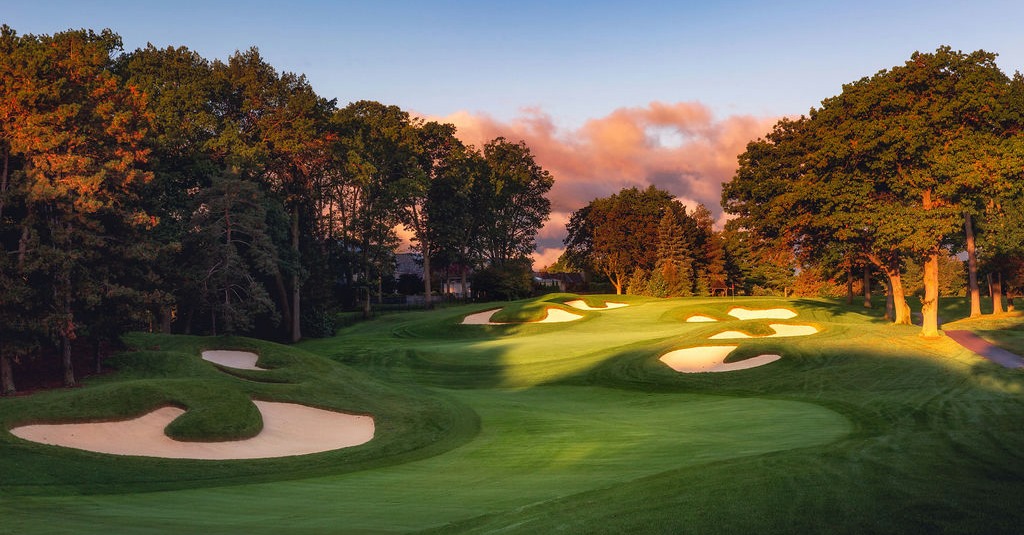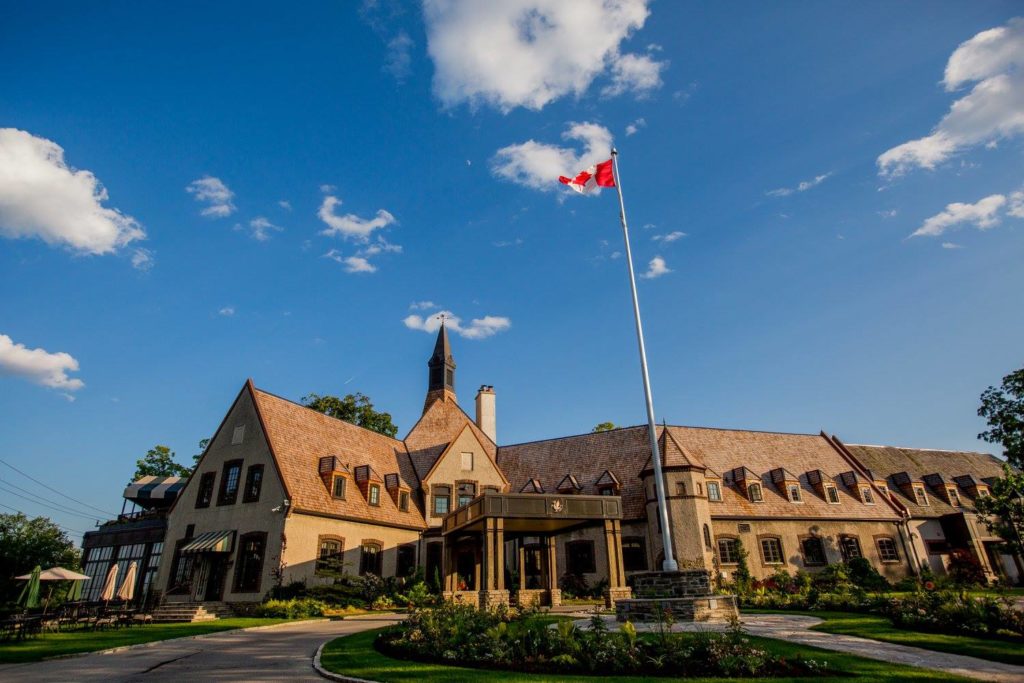
After a two-year hiatus because of COVID, the PGA Tour returns from June 6-12 to the western Toronto administrative district of Etobicoke for the RBC Canadian Open at the sublime St. George’s Golf Club, where the tournament will be played for the first time since 2010 and for the sixth time overall.
St. George’s Golf Club is perhaps the best course designed by Stanley Thompson, a Toronto native and easily the most decorated Canadian golf course architect of all time.
St. George’s has been around since 1929 and is considered the country’s best Golden Age routing, having more than stood the test of time thanks to the property’s rolling site and Thompson’s genius in making the most of what Mother Nature provided.

St. George’s Golf Club
Thompson makes his mark
Thompson hit all the right notes at this reserved, private club near downtown. The parkland-style course plays at 7,014 yards and is a par-71, running over and through natural valleys, with streams and large stands of trees defining the track’s edges and defining the holes.
Tom Doak and Canada’s Ian Andrew marshaled a restoration of the course that was completed in 2015, but St. George’s Golf Club is still all about Thompson.
St. George’s actually began as a public course (called Royal York Golf Club) and was built on one of Canada’s first golf estates. Thompson was coming off great success at Jasper Park and Banff Springs in western Canada and was at the time at the height of his prowess when he was chosen as course designer for St. George’s.
Thompson was given his pick of the 2,000-acre site for the course’s routing, and he “discovered” and built holes along, across, and often through the natural ravines and gullies that run through the property.
He created holes at St. George’s that demand course management and favor those with local knowledge to understand how to attack a track that’s chock-full of sidehill, downhill and uphill lies in a beautiful parkland setting where wind direction has to be constantly judged. St. George’s places a great premium on accuracy off the tee, with lots of tricky sloped greens, deep bunkers, and options for ways to attack the holes.

Breaking down the course
The round begins with a beautifully bunkered uphill par-4 that is followed by the tough 450-yard, par-4 second, one of several terrific driving holes that demand a precise drive down the dangerous side to set up a decent angle into the target.
On the second there is plenty of room off the tee, and the greens complex has four uniquely shaped bunkers, the type that earmark many of Thompson’s courses. The putting surface itself has a knoll front right and back left, creating numerous hole locations.
The third hole, at 208 yards, is considered the course’s – and perhaps one of Canada’s – best par-3s. It plays slightly downhill, with bunkers set about 50 yards from the green. From the tee, it feels like the putting surface is an island engulfed in sand, but there’s actually room to run up shots, especially to front hole locations.
The fourth and fifth holes feature major undulation and reward those who take an aggressive line down the right with a relatively flat lie. No. 4 is a 475-yard par-5 (it will be a par-4 for the RBC Canadian Open) that’s ingeniously routed through a valley, with the approach between a fairway bunker on the left and two more nearer the green on the right. The hillside on either side of the snaking fairway is covered in tall, native grasses, making accuracy paramount.
No. 5, carded at 454 yards, plays downhill off the tee to a contoured fairway. There’s a mound on the left side of the landing area that can kick drives down into the flat, right part of the fairway where there’s a better view of the green.
The sixth is the pitch hole at St. George’s, a 146-yard par-3 with a very wild green surrounded by sand; and missing this green almost always results in bogey.
The seventh hole, at 449 yards, is well bunkered in the landing zone, with one bunker at about 220 yards and two more on the left at the 300-yard mark. The green, considered one of the most challenging here, is on top of a knoll elevated 24 feet on the approach.
The eighth is another world-class long par-3 at 215 yards. The putting surface is cut into a hill, but again a bunker has been placed just short of the green and leaves room for a little bit of leniency.
The notorious par-4 12th plays at just 380 yards but has massive bunkers on the left side of a right-sloping fairway. The green on a ledge that is more difficult to hit the further right you stray; anything short will roll back down to the base of the hill the fairway.
The 445-yard 14th demands a long and straight drive to reach the downslope or face crossing the diagonal stream from a hanging lie. The stream on the right-hand side of the fairway is a factor for the length of the hole until cutting in front of the green complex.
The 15th, a 560-yard par-5, twists through a valley before being capped off by a putting surface perched about 40 feet above fairway. Bunkers cut into the sides of the valley to accentuate the hole’s beauty and act as another example of Thompson’s mastery of fairway bunkering. The greens complex was reworked in 1968 by Robbie Robinson in advance of the RBC Canadian Open and is considered the most intimidating on the course.
The finish at St. George’s Golf Club has the reputation of being amongst the finest in Canada and beyond. The 16th is a 204-yard par-3 that plays some 16 feet uphill, but golfers unfamiliar with the course are deceived into thinking the shot is over level terrain.
No. 17, a stout two-shotter of 470 yards, began as a short par-5, and its green is indicative of that design. It juts into a peninsula and is narrow and crowned and seems to repel all but the perfect approach; deep grassy valleys await on each side.
The final hole, a 465-yard par-4, is a last uphill challenge, moving almost 40 feet up from the landing area through mature trees to a very steep green backed by the imposing English-style clubhouse, which is actually across the street.
St. George’s Golf Club is a true test of golf. Built on glacial land, it is full of character and speaks to the land’s natural beauty. The course piques the golfer’s interest and challenges them to the best of their ability.
It is ranked No. 23 on Golf Digest’s most recent list of the World’s Best Courses outside the United States. It sits at No. 99 on Golf magazine’s ranking of all the courses in the world and is one of just seven courses on that list that host a PGA Tour event.
St. George’s Golf Club is world-class in every respect, lives up to its history, architecture, and pedigree and is deserving of every recognition. It’s hard not to imagine that Thompson, who died of an aneurysm in 1953 at age 59, is looking down and smiling, content in knowing St. George’s Golf Club has more than stood the test of time.
The RBC Canadian Open was first played 118 years ago in 1904, and has been held annually, except for during World War I, World War II, and the coronavirus epidemic, which canceled the event in 2020 and 2021. It is the third oldest continuously running tournament on the PGA Tour, after The Open Championship and the U.S. Open.
The winners of the five RBC Canadian Open played at St. George’s Golf Club were Australian Joe Kirkwood Sr, in 1933, Americans Dutch Harrison and Art Wall, in 1949, and 1960, respectively; New Zealand’s Bob Charles in 1968; and Sweden’s Carl Pettersson in 2010.

